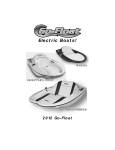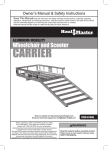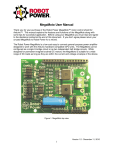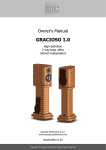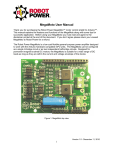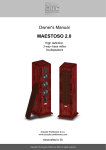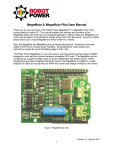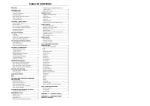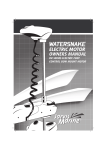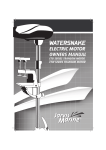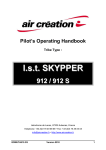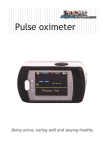Download 2013 User Manual - Go-Float Electric Boats
Transcript
® Ele ct ric Boa t s Su n Lou n ge r Se rie s 2 0 13 Own e r M a n u a l ® Go-Float Electric Boats Welcome to Go-Float We appreciate your choice of Go-Float Electric Boats for your boating pleasure. We hope you will be completely satisfied with your purchase and enjoy it for many years. Your new Go-Float has been designed to give you and your family years of trouble free fun on the water. Please read this manual carefully before operating your boat. This manual will assist you in operation, safe use, and care of your Go-Float. By taking a few moments to familiarize yourself with the functions of your Go-Float, you can help make your investment last. Please do not hesitate to contact us with questions or suggestions. We want to ensure that your boating experience is as safe and relaxing and as fun as possible. Enjoy your Go-Float! Sincerely, m The Go-Float Tea PS. Be safe… always wear a personal flotation device. Know and comply with all applicable local boating regulations. Copyright 2013 Go-Float, LLC TABLE OF CONTENTS Overview Go-Float Fusion & Impulse Overview .............................................. 4 Go-Float Vortex Overview .............................................................. 5 Operation Getting Started ................................................................................ 6 Speed Control ................................................................................. 7 Steering & Power Control ................................................................ 7 Automatic Bilge Pump ..................................................................... 7 Beach BuddyTM ............................................................................... 8 Listening to the Stereo..................................................................... 8 Monitoring the Battery Life ............................................................... 9 Charging the Battery ....................................................................... 9 Safe Boarding ............................................................................... 10 Storage and Maintenance Beaching ....................................................................................... 10 Storing On End.............................................................................. 10 Motor Maintenance........................................................................ 10 Propeller, changing ....................................................................... 11 Safety & Troubleshooting Troubleshooting ............................................................................ 12 Safety ........................................................................................... 12 Go-Float, LLC 810 First Street South Suite 110 Hopkins, MN 55343 Phone: (952) 955-9500 Fax: (952) 955-9501 Email: [email protected] Website: www.Go-Float.com Overview of Go-Float Fusion & Impulse Features Bow (front) Cooler/ Storage Compartment Fusion shown Stereo Control & Battery Meter Speed Control Cup Holder Steering Handle Starboard side Port side Seat removes to access Battery AC Plug Input Receptacle Stern (rear) Overview of Go-Float Vortex Features Bow (front) Cooler/ Storage Compartment Stereo Control Cup Holder Battery Meter & MP3 Player Storage Speed Control Steering Handle Port side Seat Back flips forward to access Battery Starboard side Stern (rear) AC Plug Input Receptacle Getting Started Congratulations on your purchase of a Go-Float electric watercraft, what we consider to be the finest and simplest electric boat on the market today! This is a sheet to simplify getting you started and on the water, enjoying your new Go-Float boat. Battery Connection: Go-Float boats are shipped with the battery(s) disconnected. If your battery meter shows a green bar that indicates charge, your batteries are already connected. If not, you will connect your battery(s) by pulling forward the seat panel (Vortex) or removing the seat tray (Fusion, Impulse). To remove the seat tray, open your cooler and unlatch the seat tiedowns that you will find in the front of the cooler. This is best accomplished with the boat resting on its hull, as the seat tray could slide forward and damage the stereo if it is set on its stern in the upright storage position. With the tie-downs unlatched, lift the seat tray from the side away from the stereo to avoid damaging the push buttons on the stereo. Inside the equipment compartment you will find red and black connectors coming from both the power buss bar and from the battery(s). Hook one connector set from the buss to a battery, if you have two batteries, hook one set to each battery. You should now have a battery charge indication. Replace the seat tray or close the seat panel. Operation: To make the boat go, select a speed on the speed selector knob and push the go-button in the grip of the steering handle with your thumb. It is best to not run the motor while the boat is out of the water, but a short test to check your motor’s operation will not harm the motor. Charging: Plug an extension cord into the charging port. This can be done while the battery(s) are connected or disconnected, but should not be done while the boat is in the water. After charging, if the meter does not show a full charge, disconnect the extension cord, disconnect the battery(s), count ten and reconnect the battery(s). Your meter should now indicate a full charge. Speed Control Each number indicates a rate of speed. “OFF 0” is neutral with no forward or reverse motion. FORWARD 1 thru 5. 1 is the slowest forward speed, good for navigating around other boats, for docking and beaching. Each higher number increases speed, with 5 being the highest speed. REVERSE 1 is a slow speed, good for navigating around other boats and for docking. REVERSE 2 is a higher speed, good for quickly slowing the boat and for spinning weeds off of the prop. The speed can be changed while the boat is underway, but it is recommended to stop the motor (release thumb pressure from the “GO” button) to change direction. Changing direction suddenly while underway could damage the motor. Steering and Power Control Handle Power “GO” Button: To turn on the motor, press the “GO” button with Right “GO” Button your thumb at the end of the steering handle. To turn off the motor, release thumb pressure from the “GO” button. IMPORTANT! Be alert for swimmers near your boat! Always release the “GO” button to turn off your motor when Left turn others approach your boat. Steering: When in forward motion, to steer right, push the handle forward. To steer left, pull the handle back. Steering directions are opposite when in reverse. Automatic Bilge Pump Automatic bilge pump. Any water that accumulates inside the hull will activate the bilge pump to automatically remove the water. Water is ejected through the hull via the round plastic fitting found on the port side of your Go-Float (shown at left). Keep this opening unobstructed during use of your Go-Float. Stereo Stereo (optional). iPod ready. Compatible with most MP3 players and other audio devices. Refer to the manufacturer’s manual included with your boat. Caution: close media tray before entering or leaving the boat to prevent damage to it. Beach BuddyTM The Beach BuddyTM, is designed to protect the motor and propeller from underwater objects while cruising or beaching your Go-Float. It is also used to stand your Go-Float on end for storage in small areas. For instructions on storing upright, see page 10. While underway it may catch weeds. If you think you have slowed because of weeds on the Beach Buddy, follow the same procedure as for removing weeds from the propeller on page 11. Wheel Kits are available to add to your Go-Float Beach BuddyTM for easier movement across lawns, driveways, etc. Do not use the Beach Buddy as a step to enter the boat. Beach Buddy with optional wheel kit for paved surfaces. Beach Buddy with optional wheel kit for sandy surfaces. Monitoring the Battery The Battery Status Indicator is specifically designed to monitor the charge status of the battery(s) onboard your Go-Float. Interpreting Battery Status. The battery indicator has ten vertical bars that light green to indicate the charge status of your battery(s). If no bar is lit, the battery (s) are disconnected or are dead. A fully charged battery will indicate a green bar on the right side of the meter, while a green bar on the left of the meter indicates a depleted battery charge. A good time to recharge your battery(s) is when the lit bar is indicated three from the left. CAUTION: This is not a fool-proof device and no warranty is made that your battery(s) condition is good. All charge levels are approximate. Charging the Battery Keep your batteries fully charged prior to use. Onboard charger. Your Go-Float is equipped with the an onboard charger, Use a UL approved three-pronged extension cord designed for outdoor use to connect to your source of electricity. The AC Plug Receptacle is located on the deck of your Go-Float. Battery(s) can also be charged with a standard automobile battery charger. Access the battery by removing the seat back (Vortex) or removing the entire seat (Fusion, Impulse). The battery may remain in the boat or be removed to recharge. Be sure to connect the battery charger to the battery poles Positive-to-Positive and Negative-toNegative. Consult your charger’s operating manual to determine the appropriate settings. AC Plug Receptacle CAUTION: Do not charge battery(s) while boat is in the water. Move your boat to dry land first. Storage Upright, Temporary: Be sure that the battery hold down strap is secured. Remove all items from the cooler-storage compartment and the passenger area. Rest the boat on a flat surface on the Beach Buddy and raise the bow until the boat is completely upright and resting on its transom. Be sure that your Go-Float is out of the wind so as not to blow over. Upright, Long Term: Follow the above procedure, but to extend the life of your battery, remove it first. Store the battery on a wooden surface, such as a piece of lumber, indoors. Use a trickle charger about every 4-6 weeks to keep the battery powered up. IMPORTANT! Use a heavy line attached to the bow eye to secure your Go-Float to a solid fixture, such as a rafter. This will prevent your GoFloat from accidently falling over. Do not store upright outdoors—wind may blow over. Vortex not recommended for upright storage. Beaching IMPORTANT! When your Go-Float is on shore in a horizontal position, it is recommended that you do not step into the boat. Serious damage may occur to the hull, deck, and Beach BuddyTM. Battery The battery included with your boat is sealed, so do not worry about it leaking during upright storage. Safe Boarding With your Go-Float in the water, to safely board, step as far as you are able into the center aft portion of the seat. This will keep the boat as stable as possible while you are boarding. This will also place your weight onto the strongest area of the deck. Reverse the procedure for safe disembarking. Bow Eye Changing the Propeller Before doing anything with the propeller, ensure the cables to the battery are disconnected. Detaching the propeller it is a simple matter of unscrewing and removing the locknut using the special tool supplied. When doing this, take hold of the propeller to stop it turning. Under no circumstances should you attempt to loosen the locknut with a hammer or similar tool as this may damage the locknut or shaft – or both. (F) Once the locknut is removed, you will be able to slide the propeller off. When putting the propeller back on, verify there is a proper fit of the groove and shear pin otherwise the propeller will not be locked in place. (G) After using the motor always check and clear any weed or fishing line that may have become tangled around the propeller. Next, give the motor a wipe down with warm water to remove any salt or sand particles and then spray it with fresh water. Motor Maintenance We recommend after use to rinse motor to remove sand and other debris. Check the propeller for line or weeds. Regularly check for loose fasteners, corroded or loose terminal connections and frayed wires. Keep moving parts lubricated. An aerosol lubricant works well. Electrical Connections Before removing or installing the battery, ensure that all switches are in the OFF position and have the propeller area clear. If replacing or adding a battery, we highly recommend ordering your battery from GoFloat to ensure safety and good performance. Troubleshooting Symptom Possible Cause/Solution Speed loss 1. Check for weeds or fishing line on the propeller and remove. 2. Check battery charge status. 3. Check battery connections. Motor noise or vibration 1. Check propeller for weeds or fishing line. 2. Check to see propeller is secure and not damaged. Weeds on prop Weeds on Beach BuddyTM Weed Removal while Underway: 1. Set the speed control at Forward 5 and spin the propeller briefly. 2. Stop the motor, set the speed at Reverse 2 and spin the propeller briefly. 3. Reset the speed to forward and check for improved performance. 4. Repeat steps 1-3 until weeds are cleared and satisfactory performance has returned. Weeds on prop Weeds on Beach BuddyTM Weed Removal Manually: CAUTION! TURN MOTOR OFF before attempting to remove weeds by hand. Boating Safety Personal Flotation Device. We recommend that a proper personal flotation device be worn by all occupants of the boat. Motor and Prop. Always watch for other boaters or hazards while on the water. This boat is not designed to be a swimming or diving platform. Watch out for swimmers near your boat. Spinning props can cause serious injury or death. Motor. Do not run the motor out of the water. The motor needs to be submerged in water to stay cool. Running the motor when dry can seriously damage motor’s seals. Go-Float Electric Boats can not be responsible for accidents due to misuse, modifications or for using the boat in any manner other than its intended use.












